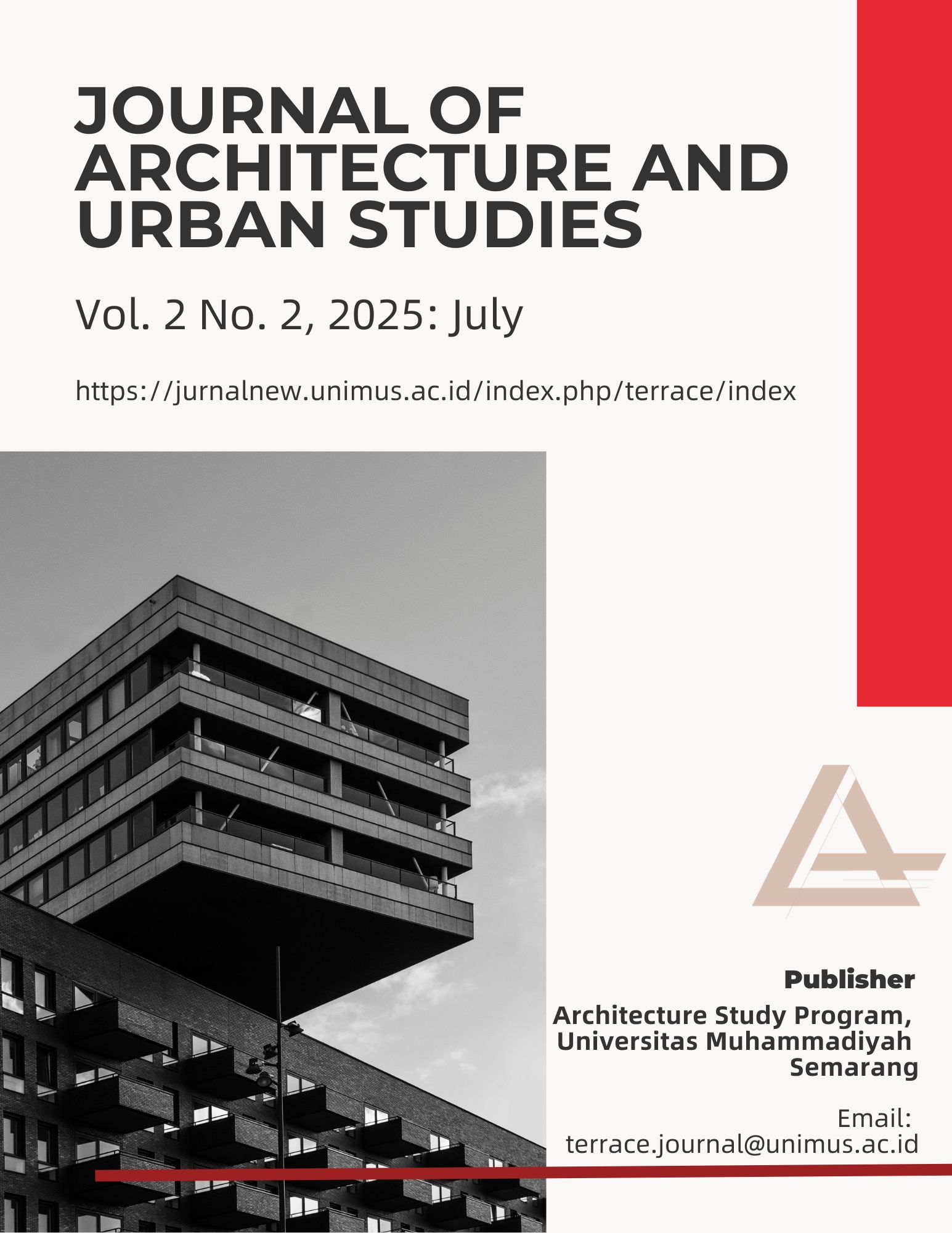Evaluation of Thermal Conditions Using Temperature, Relative Humidity, and Air Velocity Parameters in the At-Taqwa Mosque Hall, Universitas Muhammadiyah Semarang
Keywords:
thermal comfort, air temperature, relative humidity, air velocity, natural ventilationAbstract
Thermal comfort is an important factor in the design of a mosque hall used by many congregants for long periods of time. The At-Taqwa Mosque hall of Universitas Muhammadiyah Semarang is frequently used for various activities, but its thermal condition has never been evaluated. This study aims to evaluate the hall's thermal condition based on parameters of air temperature, relative humidity, and air velocity. The method used is a descriptive quantitative approach. Data collection was carried out by measuring temperature, humidity, and air velocity directly at five points from 06.00–18.00 WIB. Analysis was carried out by comparing the results with thermal comfort standards in humid tropical climates (ASHRAE 55 and SNI 03-6572-2001). The results showed a temperature range of 26.4°C–29,9°C and a relative humidity of 76.8%–88.5%. Wind speed ranged from 0.15–0.5 meters/second. The measurement results showed that the air temperature experienced a gradual increase from an average of 26.4°C in the morning to a peak of 29,9°C during the day. Relative humidity showed a decreasing trend from an initial value of 88.5% to as low as 76.8% and increased towards the afternoon, in line with the increase in temperature. Air velocity increased from 0.15 meters/second to a maximum of 0.5 meters/second at midday. These findings emphasize the importance of planning a strategy for managing air temperature, relative humidity, and air velocity parameters in achieving thermal comfort in a room. Optimization strategies for air circulation and natural ventilation management in closed spaces with passive and active ventilation system designs for tropical public spaces to support comfort, energy efficiency, and environmental health in the context of worship. The conclusion is that the mosque hall has the potential for thermal discomfort, so passive design improvements such as cross ventilation and shading are needed.
References
A. F. K. Thoha, S. Qisom, and F. Al-Qarni, “Optimalisasi Masjid Perumahan Sebagai Ruang Publik dan Poros Kegiatan Masyarakat,” Masjiduna Junal Ilm. Stidki Ar-Rahmah, vol. 4, no. 1, p. 29, 2021, doi: 10.52833/masjiduna.v4i1.79.
M. A. Hamdy1 et al., “Lingkungan dan Kenyamanan Termal Dalam Bangunan di Iklim Tropis Panas dan Lembab: Studi Literatur Sistematik,” JaS), vol. 3, no. 2, pp. 25–44, 2021, [Online]. Available: https://ejournalfakultasteknikunibos.id/index.php/jas/.
K. A. Umah and Avif Alfiyah, “Rekonstruksi Peran Dan Fungsi Masjid Sebagai Ruang Publik,” Al-Musthofa J. Sharia Econ., vol. 6, no. 2, pp. 175–190, 2023, doi: 10.58518/al-musthofa.v6i2.2206.
A. P. Harahap, A. R. Thahir, and S. Handjajanti, “Peran Masjid Sebagai Pembentuk Identitas Tempat the Role of Mosque As Place Identity Formation,” J. AGORA, vol. 17, no. 1, pp. 53–56, 2020, [Online]. Available: https://www.e-journal.trisakti.ac.id/index.php/agora/article/view/7521.
R. Mulyadi et al., “Kondisi Lingkungan Termal Ruang Kelas Sekolah Menengah di Area Suburban pada Masa Pandemi COVID-19,” J. Lingkung. Binaan Indones., vol. 12, no. 1, pp. 13–21, 2023, doi: 10.32315/jlbi.v12i1.69.
H. Anam and H. R. Agustapraja, “Analisis Kenyamanan Thermal pada Ruang Dalam Masjid Agung Tuban Menggunakan Simulasi Software Ecotect Analysis,” Tekstur (Jurnal Arsitektur), vol. 6, no. 1, pp. 40–47, 2025, doi: 10.31284/j.tekstur.2025.v6i1.6452.
N. R. Syamsiyah and H. Nur Izzati, “Strategi Kenyamanan Termal Masjid Al-Kautsar Kertonatan, Kartasura, Sukoharjo,” Langkau Betang J. Arsit., vol. 8, no. 2, p. 98, 2021, doi: 10.26418/lantang.v8i2.45792.
M. A. Taqwim S, G. Hardiman, and W. S. Budi, “Kondisi Thermal Masjid Al-Fairus Pekalongan,” Arsitektura, vol. 18, no. 1, p. 27, 2020, doi: 10.20961/arst.v18i1.31418.
W. N. A. Hisyam, “Evaluasi Pencahayaan Alami Dan Kenyamanan Termal,” Semin. Ilm. Arsit., vol. 5, no. 2, 2024.
E. I. Santoso, “Kenyamanan Termal Indoor Pada Bangunan Di Daerah Beriklim Tropis Lembab,” Indones. Green Technol. J., vol. 1, no. 1, pp. 13–19, 2012, [Online]. Available: https://www.neliti.com/publications/63463/.
I. N. Sandi, I. G. Ariyasa, I. W. Teresna, and K. Ashadi, “Suhu Tubuh Latihan Effect of Relative Humidity on Body Temperature Changes,” Sport Fit. J., vol. 5, no. 1, pp. 103–109, 2017.
Latifah; and R. Widiastuti, “Identifikasi dan evaluasi pengaruh ventilasi alami pada ruang kelas terhadap fenomena sick building syndrome,” J. Sipil dan Arsit., vol. 1, no. 3, pp. 25–30, 2023.
M. Kusyanto and R. R. Rihadiani, “Keruangan Di Masjid Menghadapi Pandemi Covid-19 Berbasis Ventilasi Alami (Studi kasus : Masjid Al Azhar Jungpasir Demak ),” 2021.
Z. Zuraihan, A. Munandar, and F. Muliani, “Analis Indeks Kenyamanan Ruang Dengan Pendekatan Iklim Dan Material,” Agora J. Penelit. dan Karya Ilm. Arsit. Usakti, vol. 21, no. 2, pp. 135–149, 2023, doi: 10.25105/agora.v21i2.18128.
M. Kusyanto, S. Triyadi, and S. Wonorahardjo, “Kualitas Ruang Masjid Berkubah yang Dibangun Masyarakat Secara Swadaya dari Aspek Kenyamanan Termal di Kabupaten Demak,” J. Lingkung. Binaan Indones., vol. 6, no. 3, pp. 134–143, 2017, doi: 10.32315/jlbi.6.3.178.
Y. Kukus, W. Supit, and F. Lintong, “Suhu Tubuh: Homeostasis Dan Efek Terhadap Kinerja Tubuh Manusia,” J. Biomedik, vol. 1, no. 2, 2013, doi: 10.35790/jbm.1.2.2009.824.
L. R. Amaliya and R. Ginanjar, “Pelabuhan Tradisional Desa Eretan Wetan Kecamatan Kandanghaur Kabupaten Indramayu Tahun 2018,” J. Mhs. Kesehat. Masy., vol. 2, no. 1, 2019.
Downloads
Published
How to Cite
Issue
Section
License
Copyright (c) 2025 Journal of Architecture and Urban Studies

This work is licensed under a Creative Commons Attribution-NonCommercial 4.0 International License.












